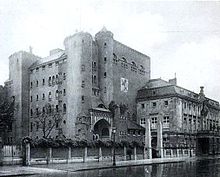Schauspielhaus Düsseldorf
The Schauspielhaus Düsseldorf , founded on June 16, 1904 by Louise Dumont and Gustav Lindemann in conjunction with ten partners from industry, administration and the art academy as a GmbH, was located on Carl-Theodor-Strasse at the corner of Kasernenstrasse . It was built by the construction company Boswau & Knauer from 1904 to 1905 according to a design by the Berlin architect Bernhard Sehring and opened by Friedrich Hebbel on October 28, 1905 with the tragedy Judith .
The Schauspielhaus Düsseldorf was in direct competition with the municipal city theater Düsseldorf , later the city theaters of Düsseldorf. With its ambitious program and aesthetic and artistic achievements, it became the "Vorbühne des Westens" ( Carl Niessen ). In 1932, after the death of Louise Dumont, Gustav Lindemann and Cologne's Lord Mayor Konrad Adenauer tried to merge with the Cologne theater under the name “Deutsches Theater am Rhein”. The Nazi takeover of power in 1933 prevented the project from continuing.
At the beginning of the 1933/34 season, the building was rented to the Städtische Bühnen Düsseldorf as an additional venue . The name “Schauspielhaus” was retained for the stage. The Schauspielhaus came to an end as an independent cultural institution. During the Pentecostal attack on June 12, 1943 , the building was destroyed and not rebuilt afterwards.
The IKB industrial credit bank was built on the site of the completely destroyed building, the ruins of which were laid down in the summer of 1952 . With the exception of a plaque on the new building, all traces of Dumont and Lindemann's private theater were removed from the Düsseldorf cityscape.
The Düsseldorfer Schauspielhaus , initiated by Gustaf Gründgens in 1951 , which was located in the restored former operetta house (Kleines Haus der Städtische Bühnen, Düsseldorf) on Jahnstrasse until 1970 and today dominates Gustaf-Gründgens-Platz next to the Dreischeibenhaus , founded a new tradition of its own. which is derived from the Städtische Bühnen Düsseldorf .
description
The house had a reduced ranking system. The upper of the two tiers was no longer carried to the proscenium and was restricted to the rear part of the auditorium. The seating on the ground floor was expanded in a wedge shape and the lateral ground floor lounges were omitted. At the same time, the proscenium boxes and associated boxes were dispensed with.
The auditorium was built in the neo-baroque style. It thus corresponded to one of the possibilities for the design of theaters at that time ( historicism ). The stage house assigned to him, however, was built in the then new architectural style of reform architecture . The cube, made of exposed brick walls, with round towers and battlements, had a “fortress-like character” and was based on the local history of the place ( heritage protection architecture ). The written history of Düsseldorf's urban area begins with the founding of a monastery in Kaiserswerth , where Emperor Friedrich Barbarossa later built a new imperial palace as a mighty customs fortress to pay the Rhine customs .
The building was characterized by the contrast between the auditorium and the stage - while the auditorium still maintained historicism, the architects had given up the traditional style of the stage in order to devote themselves to the new architecture with the care of the regional building tradition - “This polarity of the two most important The Düsseldorfer Schauspielhaus sets parts of a theater of the stage and the auditorium in clear contrast to all other Rhenish theaters around the turn of the century, in which, despite the general emphasis on the stage houses, the aim was obviously to create a self-contained complex.
literature
- Michael Brockerhof: Düsseldorf as it was. 6th edition, Droste, Düsseldorf 2008, ISBN 978-3-7700-1277-0 , p. 130, p. 131, p. 132 and p. 133.
- Freihochschulbund (ed.): The theater in Düsseldorf. A quarter of a century of German stage art. Ed. Lintz, Düsseldorf 1930.
- Community of Friends of the Düsseldorfer Schauspielhaus (ed.): Deutsches Theater am Rhein. Louise Dumont and Gustav Lindemann in honor of the 25th anniversary of the Düsseldorfer Schauspielhaus on October 28, 1930. A. Bagel, Düsseldorf [1930].
- Thomas Kuhn: theater. In: Roland Kanz, Jürgen Wiener (eds.): Architectural guide Düsseldorf. Dietrich Reimer, Berlin 2001, No. 50 on p. 40.
- Kurt Loup (Ed.): The festive house. The Dumont-Lindemann theater in Düsseldorf. Mirror and expression of time. Kiepenheuer & Witsch, Cologne, Berlin 1955.
- Theo Lücker: Düsseldorf - around Karlstadt. Verlag Goethe-Buchhandlung Düsseldorf, Düsseldorf 1990, pp. 224–228 (The theater and its further development. Instead of the theater, the rounded block of the industrial bench was built).
- Michael Matzigkeit: literature on the move. Writer and theater in Düsseldorf 1900–1933. Verlag Goethe-Buchhandlung Düsseldorf, Düsseldorf 1990, pp. 123-268, 291-309.
- Winrich Meiszies (Hrsg.): Century of the drama. From the Schauspielhaus Düsseldorf to the Düsseldorfer Schauspielhaus. Droste, Düsseldorf 2006, pp. 13–65; 270-275.
- Heinrich Riemenschneider: Theater history of the city of Düsseldorf . Verlag Goethe-Buchhandlung Düsseldorf, Düsseldorf 1987, Volume 2, pp. 9-122.
- Ingeborg Schild : Theater . In: Eduard Trier, Willy Weyres (Ed.): Art of the 19th century in the Rhineland . tape 2 . Architecture: II, secular buildings and urban planning . Schwann, Düsseldorf 1980, ISBN 3-590-30252-6 , pp. 173-190 .
- Paul Ernst Wentz: Architecture Guide Düsseldorf. Droste, Düsseldorf 1975, ISBN 3-7700-0408-6 , object no. 12.
Web links
Individual evidence
- ↑ Peter Hüttenberger: Düsseldorf in the time of National Socialism. In: Hugo Weidenhaupt (Ed.): Düsseldorf. History from the origins to the 20th century. Volume 3 . Schwann / Patmos, Düsseldorf 1988, ISBN 3-491-34221-X , p. 635.
- ↑ Anonymous: Demolition of the old theater. In: Der Mittag , Düsseldorf, August 15, 1952.
- ^ Jürgen Wiener: Introduction to the architectural history of Düsseldorf. In: Roland Kanz, Jürgen Wiener (eds.): Architectural guide Düsseldorf. Dietrich Reimer, Berlin 2001, pp. XI – XXII, on this p. XX.
- ↑ a b Schild, p. 188f
Coordinates: 51 ° 13 ′ 12.3 " N , 6 ° 46 ′ 33.1" E




